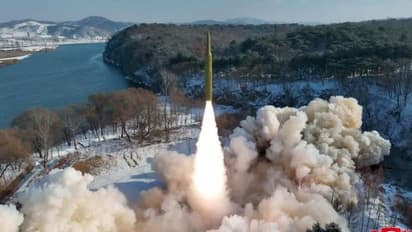North Korea claims it tested new missile with hypersonic warhead

Synopsis
The missile, featuring solid-fuel technology, aims to enhance launch readiness and mobility while reducing detectability. The test focused on verifying the missile's reliability and the hypersonic warhead's manoeuvrable flight capabilities.
North Korea has announced the successful flight test of a new intermediate-range missile equipped with a hypersonic warhead. The test marks the North's pursuit of more potent and harder-to-detect weaponry, specifically designed to target remote U.S. locations in the region. The report from North Korea's state media followed the detection of the missile launch by the South Korean and Japanese militaries a day earlier. This marks North Korea's first ballistic test in 2024, coming two months after the country claimed a successful test of engines for a new solid-fuel intermediate-range missile.
The Korean Central News Agency (KCNA) reported that the launch aimed to verify the reliability of the missile's solid-fuel engines and the manoeuvrable flight capabilities of the hypersonic warhead. While KCNA declared the test a success, it did not provide specific flight details or mention the presence of North Korean leader Kim Jong Un.
South Korea's Joint Chiefs of Staff stated that the missile covered approximately 1,000 kilometres (620 miles) before landing in the waters between the Korean Peninsula and Japan. Notably, the use of solid propellants in the missile allows for quicker launch readiness, enhanced mobility, and concealment, making it more challenging for adversaries to detect and preempt the launch.
Military analysts suggest that the test primarily focused on developing a solid-fuel first stage for an intermediate-range ballistic missile (IRBM) rather than evaluating the hypersonic warhead. The North has been actively testing hypersonic weapons since 2021, with potential capabilities to challenge regional missile defence systems due to their high speed and manoeuvrability.
Chang Young-keun, a missile expert, indicated that North Korea might be concurrently working on a hypersonic weapons system powered by solid-fuel booster rockets while developing the new IRBM. The use of hypersonic missiles with IRBM-level range could pose a significant challenge to U.S. missile defences, particularly in targeting locations like Guam.
Lee Sung Joon, spokesperson for South Korea's Joint Chiefs of Staff, mentioned that the military is analyzing the latest test but refrained from providing specific assessments regarding North Korean capabilities demonstrated in the launch.
This development comes amid heightened tensions on the Korean Peninsula, with North Korea ramping up weapons demonstrations in recent months. The United States and its allies, South Korea and Japan, have responded by strengthening joint military exercises and refining nuclear deterrence strategies. Additionally, there are concerns about potential arms cooperation between North Korea and Russia, evidenced by a recent diplomatic visit by a North Korean delegation to Russia led by Foreign Minister Choe Sun Hui. The details of their discussions remain undisclosed.
Also Read: After US, now UK warships to get serviced at Indian dockyards
Check the Breaking News Today and Latest News from across India and around the world. Stay updated with the latest World News and global developments from politics to economy and current affairs. Get in-depth coverage of China News, Europe News, Pakistan News, and South Asia News, along with top headlines from the UK and US. Follow expert analysis, international trends, and breaking updates from around the globe. Download the Asianet News Official App from the Android Play Store and iPhone App Store for accurate and timely news updates anytime, anywhere.